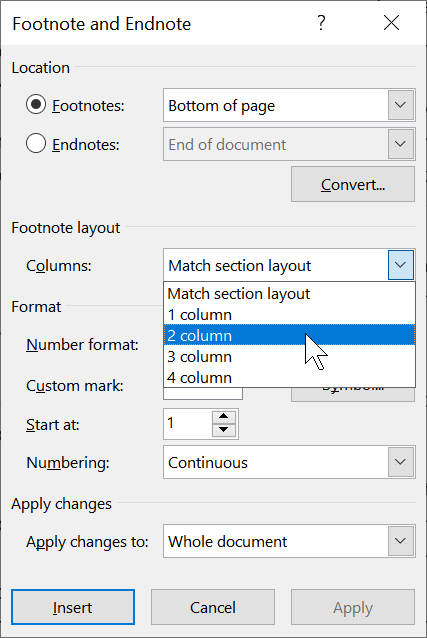Please Note: This article is written for users of the following Microsoft Word versions: 2007, 2010, 2013, 2016, 2019, and 2021. If you are using an earlier version (Word 2003 or earlier), this tip may not work for you. For a version of this tip written specifically for earlier versions of Word, click here: Footnotes in Two Columns.
Written by Allen Wyatt (last updated April 24, 2021)
This tip applies to Word 2007, 2010, 2013, 2016, 2019, and 2021
Word includes the ability to place footnotes at the bottom of each page in your document. By default, the footnotes are placed into the same number of columns as you are using in the document. Thus, if your document uses two columns, then the footnotes will be placed into two columns, as well. In general, each of the footnotes appears under the same column in which the footnote reference appears.
Word 2013 added the ability to have your footnotes appear using a different number of columns than the main body of your text. (This is a huge formatting boon for those using footnotes.) Insert your footnotes as normal, but then follow these steps:

Figure 1. The Footnote and Endnote dialog box.
At this point Word reformats any existing footnotes so that they match whatever number of columns you specified in step 4. You don't have any control over the width of the individual columns; Word makes them all of equal width.
If you are using an older version of Word and you want your footnotes to appear in a different number of columns than your document does (for instance, two columns of footnotes when the body is a single column), you are out of luck; Word can't handle it. You could work around the problem by "faking" the footnotes, meaning to enter them manually (as regular text) and placing the notes themselves in a multi-column table placed at the bottom of the page. Of course, your footnotes won't automatically renumber, and they won't flow from page to page as you add or remove text from the body of the document.
If your desire is to have your footnotes in a single column while your text body is in multiple columns, the folks at the Word MVP site have come up with a workaround. You can find it here:
http://wordfaqs.ssbarnhill.com/FootnotesSpanColumns.htm
WordTips is your source for cost-effective Microsoft Word training. (Microsoft Word is the most popular word processing software in the world.) This tip (8961) applies to Microsoft Word 2007, 2010, 2013, 2016, 2019, and 2021. You can find a version of this tip for the older menu interface of Word here: Footnotes in Two Columns.

Create Custom Apps with VBA! Discover how to extend the capabilities of Office 365 applications with VBA programming. Written in clear terms and understandable language, the book includes systematic tutorials and contains both intermediate and advanced content for experienced VB developers. Designed to be comprehensive, the book addresses not just one Office application, but the entire Office suite. Check out Mastering VBA for Microsoft Office 365 today!
When you add a footnote to a document, Word's normal formatting adds a space after the footnote number and before the ...
Discover MoreWhen you print a document that uses footnotes, Word normally places a small line between the end of the document body ...
Discover MoreWhen inserting footnotes and endnotes in a document, most of us don't give much thought to the format used in the ...
Discover MoreFREE SERVICE: Get tips like this every week in WordTips, a free productivity newsletter. Enter your address and click "Subscribe."
2025-04-08 19:33:26
elby
I appreciate you so much! Saved my bacon.
2024-02-29 21:57:43
eric
That worked! Thank you. :-)
2022-04-11 12:05:23
Paul Cusack
Thank you very much for sharing this tip. Saved me time trawling through google searches for an answer - 5 Stars!
2021-11-19 07:20:18
Andrew B
I just cant make this work - I have tried puttin endnotes and footnotes into two or four columns - while the main text is in just normal single column. You say 'select 2 columns and the click OK - but there is no OK button, just Apply or Insert - have tried both. Have seen suggestions that getting endnotes in columns may only work if its done when you insert the first endnote, but however I try , cant make it work. I dont think I have seen an actual demonstration of it working. So frustrating. Am using Word Office 365 . Am I just stupid?
2021-06-16 23:03:30
Janet Neubecker
If you got a neck rub and a dollar for every time you have saved someone's butt, you would be a happy man. I don't think you get thanked one iota the amount you are due! So, Thank You! once again, Mr. Wyatt.
2021-06-12 19:06:46
Becky
Thanks for your helpful comment. Will this work for endnotes as well? I'm having a difficult time getting my endnotes into 2 columns.
2021-04-25 04:35:35
Arya Larijani
Thank you. This is really helpful
Got a version of Word that uses the ribbon interface (Word 2007 or later)? This site is for you! If you use an earlier version of Word, visit our WordTips site focusing on the menu interface.
Visit the WordTips channel on YouTube
FREE SERVICE: Get tips like this every week in WordTips, a free productivity newsletter. Enter your address and click "Subscribe."
Copyright © 2025 Sharon Parq Associates, Inc.
Comments